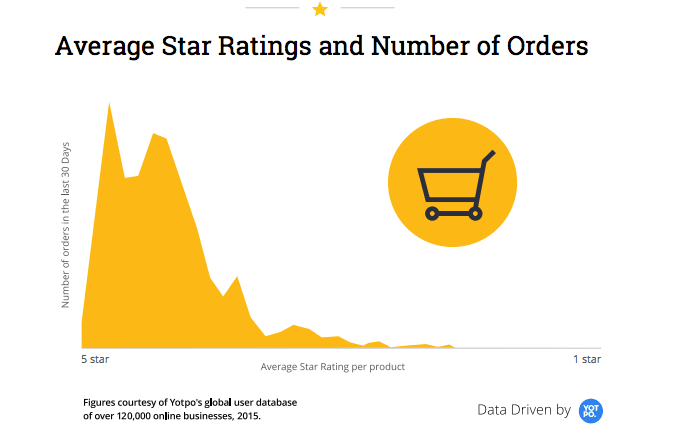Ally Financial Is Contacting My Family Members on Cell Phones Where Numbers Are Not Listed
If you lot desire to get people to buy your stuff, you need to understand how consumers make purchasing decisions.
People research products. They compare competitors. Some 87% of buying decisions begin with research conducted online, usually on Amazon or Google.
Product quality and seller reputation thing, of course. But what about when the product matches the customer's needs and they trust the seller? What influences a purchase determination once those fundamentals are in place?
Here are 9 things yous should know if you lot want to win over customers every bit they make a decision to buy.
i. Reviews affair for deciding on products and companies.
Many studies in recent years take confirmed what we already know: People read reviews and determine what to buy based on them.
Some 88% say they trust online reviews as much as personal recommendations, and 39% read reviews on a regular basis. In fact, merely 12% of those surveyed don't read reviews at all. (And that was a few years ago.) Nosotros've written at length on the impact of user-generated reviews.

So showtime gathering reviews on your site. If you sell commodity products, you lot might want to pull reviews from an external site so that yous can brandish more of them. Use structured information to go review stars from highly reviewed products into search results. Our internal report on the impact review stars showed that they can increase click-through-rates by as much as 35%.
More reviews can help insulate your reputation from the inevitable impossible-to-please customer. That said, don't delete negative reviews. They actually assist sales if at that place are merely a few of them and they're politely worded.
If there are tons of negative reviews, well-nigh people are naturally turned off and wait elsewhere.
2. People gather buying recommendations from mixed sources.
Even though social media and the Internet rule, customers make buy decisions using a combination of one-time media, new media, and conversations with friends and family unit. (To read more about this, I encourage you to check out People Comparison Store, Stupid.)
According to a 2009 study by Harris Interactive, the near mutual methods for gathering information prior to making a purchase are:
- using a visitor website (36%);
- face-to-face conversation with a salesperson or other company representative (22%);
- contiguous conversation with a person not associated with the company (21%).
Some other, slightly more than recent, report claims that 59% of people still consult friends and family for help with a purchase decision.

Asking people around us for recommendations remains commonplace. This means the feel yous provide to your customers matters a slap-up deal.
Omnichannel journeys are on the rise equally well. Customers are no longer relying on unmarried sources. According to recent research, 73% of retailers say omnichannel is important to them, simply only 38% say they are beyond the beginning stages of an omnichannel journeying.
3. People don't often know why they similar something.
In that location's a famous report about jam tasting. Scientists asked a big sample of consumers to rank jams on taste, ordering them from top to bottom.
Then the scientists re-did the study with a different, but even so statistically representative, group. This time, they asked the sampler to put the jams in gild of taste and explain their thinking. The order flipped. The jams that the first group ranked as the best tasting were judged to every bit the worst past the 2d grouping.
The reason is that the witting brain all of a sudden got involved in a chore information technology didn't really understand. Suddenly, in that location were social pressures (i.eastward. what they should cull), leading answers abroad from what people really liked.
People make instant decisions with their subconscious. When they have to explain the choice, the choice may modify completely because the rational mind is involved. (To larn more about rational and irrational thinking, bank check out our articles on System 1 and Organization 2.)
Takeaway: Don't trust people when they explain why they bought something. They might not know themselves.
4. The crowd leads the manner to buyer preferences.
Most of our preferences are learned and formed by social norms and expectations.

An oldWashington Mail cavalcade uses the example of clam chowder. Decades ago, information technology was thin. But now, it's almost uniformly thick. What happened? At some bespeak, restaurateurs got in the habit of adding flour to make chowder thicker and thicker. Now, this is what consumers have come to consider a bowl of "authentic" clam chowder.
These learned preferences can but as easily involve characteristics that, from an objective standpoint, don't make a product whatever better—and might even make them worse, especially when it comes to texture.
Ravi Dhar, a marketing professor at the Yale School of Management, notes that although Heinz ketchup does not reliably win in blind taste tests, it has established itself as the gold standard in its category because it's thicker. In the marketing world, Dhar says, "meaningless attributes often atomic number 82 to meaningful differentiation."
Ever wondered why and so many products on store shelves are so similar? Wouldn't information technology be better to make them dissimilar? Not necessarily.
"There are huge incentives in consumer markets, even for competing companies, to make everything the same, " says Dan McGinn, president of a enquiry and strategy consultancy in Arlington, Virginia.
Yes, our preferences evolve as society evolves. That impacts our purchasing decisions. A "family car" used to mean a station wagon. Then it was a minivan. At present, it's an SUV.
If you're interested in this concept, we've written an commodity on the idea of familiarity as a marketing tactic. Essentially, the more we're exposed to something, the more likely it is that we'll develop a preference for it and decide to buy it.
Takeaway: In markets where people have a lot of experience with the production category, it pays to mimic the market standard.
five. Simplicity e'er wins for controlling.
Cognitive fluency is the human being tendency to prefer things that are not only familiar, but also easy to understand. (That's why simple sites are scientifically better.)
For marketers, this means that the easier it is to understand an offer, the more likely people are to buy it.
Psychologists have determined, for example, that shares in companies with easy-to-pronounce names significantly outperform those with hard-to-pronounce names. Coincidence? Nope.
Why people love to buy unlimited plans.
Understanding and comparing unlike cell-phone plans is a pain. It takes time to place the all-time option. Who wants to spend xx minutes comparing monthly minutes and text limits? Then what do people do? They buy the unlimited plan. It's often not the best value, simply it's easy to understand.

Cell telephone companies make the most money from unlimited plans, and they have an extra incentive to make other plans confusing. Plans with a stock-still number of minutes charge high fees for going over your allotted minutes. It's designed to cause you plenty pain that y'all switch to a programme with a higher regular fee.
Previous positive experiences matter.
Cognitive fluency also explains
- Why you continue to buy from brands and service providers yous've used before
- Why you often social club the same matter from the menu.
It's just easy. You've tried it, it worked, and you don't want to spend a bunch of time researching alternatives. You don't desire to risk a bad purchase.
As a marketer, this ways it'south super important to become a customer to decide on that commencement purchase. Pack your commencement offering with value and make it as piece of cake as possible to buy. One time consumers take their first positive buying feel, it's much easier to get repeat purchases.
Hard to read, hard to buy.
Make your website easy to read. When people read something in a difficult-to-read font, they transfer that sense of difficulty onto the topic they're reading about.
The same goes for products and purchases. We've conducted a number of original studies on ecommerce production pages. In one of those studies, nosotros found that the way products are described matters. The format of text descriptions influences how people perceive the products themselves.
Takeaway: Make every aspect of the decision to purchase every bit simple every bit possible.
6. For retail stores, even floor influences purchasing decisions.
Enquiry by Joan Meyers-Levy suggests that the way people guess products may be influenced by the basis below them.
"When a person stands on carpeted flooring, it feels comforting," says Meyers-Levy. "Merely the irony is that when people stand up on carpet, they volition guess products that are shut to them equally less comforting."

When people were standing on soft carpet and viewed a production that was moderately far away, they judged that item's advent to be comforting. However, people who examined products while standing on the same plush carpet judged items that were shut by as less comforting.
This translates online as well. The way things are presented and emotional factors come into play. It'due south your responsibility to be aware of them and manage them accordingly. Seemingly unimportant details can affect consumers' conclusion to buy or click away.
Takeaway: Cover walking areas in your retail store with soft carpet, but utilise hard floor side by side to products.
In that location's conflicting research on the influence of social media on purchase decisions. One study found that consumers are 67% more likely to buy from brands they follow on Twitter.
Some other report showed that social media rarely leads straight to online purchases. Data indicated that less than 2% of orders resulted from shoppers coming from a social network. The report plant that email and search advertising were much more effective vehicles for turning browsers into buyers.
The deviation between these two studies is that the get-go was based on what people said, merely the second was based on what people actually did. (However, they were tracking direct click-throughs from social media, not taking into account the positive influence information technology may accept over time.)
The real answer is that social media probably impacts purchase decisions, only it's a tiresome, human relationship-building process. Just shouting "buy this" works on a very small-scale number of people.
Even equally social media purchases continue to increase—nearly one-half of survey respondents in 2017 had made a purchase straight through Facebook—a full 3rd of the market place had all the same to buy via social media. Less than i in ten bought from any social channel other than Facebook.
A study examined how the presence of a Facebook "Similar" button and the Twitter logo might affect online purchase decisions.
The findings:
- When the product was one for which public consumption is desirable (sportswear, fragrance), the presence of the Facebook and Twitter icons made people 25% more probable to purchase.
- When the product was more than private in nature (Spanx, Clearasil), the presence of Facebook and Twitter icons made participants 25% less likely to purchase.
Does buying your production make your customer seem more than or less cool? Identify the Facebook and Twitter icons accordingly.
8. When it comes to buying, we make emotional decisions and rational justifications.
Practice people make decisions based on emotions or logic? McCombs marketing professor Raj Raghunathan and PhD student Szu-Chi Huang betoken to their research study.
The study shows that comparative features are important but mostly as a justification for after a heir-apparent makes an emotional decision. Here'southward how they ran their study.
The story of two chickens
Research participants were shown two photos. One was a nice-looking, plump craven. The other was a craven that looked thin and sickly. Participants were told that the plump chicken was a natural chicken and that the thin craven was genetically engineered.

Researchers informed half the participants that natural chickens were healthy (but less tasty) and genetically engineered chickens were tasty (but less healthy). The other half were told the reverse.
Overwhelmingly, participants preferred the plump chicken, but their reasoning was unlike:
- The offset group claimed that it was because they valued wellness above taste.
- The second group said it was because gustatory modality was more important.
Neither grouping justified their option based on how they felt near the chicken's looks. They felt compelled to justify their emotional choices with rational reasons—to the indicate that the two groups gave opposing accounts to justify the same "buy" decision.
Emotions rule in all areas of buying behavior.
The scientists replicated the results in other areas, including marketing, politics, religion, etc.
"This process seems to be happening somewhat unconsciously, people are non actually aware they're coming upwards with these justifications. What is even more interesting is that people who claim that emotions are not that of import, who consider themselves to exist really rational, are actually more decumbent to fall into this trap."
What does this mean for marketers? Raghunathan suggests that the earlier you tin make an emotional connection, the better. One time consumers have decided that they similar a particular choice, information technology'south difficult for them to backpedal. Rational thinking will only justify their emotional choice.
(You might too be interested in reading most how consumers use mail service-buy rationalization to avoid buyer'due south remorse. The brain doesn't like to think information technology made an emotional decision, so we assign rational reasons for our decisions post-buy.)
9. The subconscious drives buy decisions.
For the last fifty or 60 years, market place research, as an industry, has believed that people make decisions based on rational, witting thought processes. Science tells a dissimilar story, i that turns that fundamental belief on its head. Most controlling happens at the subconscious level.
We may focus on facts and numbers, but in many cases, it'southward the subliminal that makes people decide one style or another.
Conclusion
People are complex. We're merely outset to scratch the surface of what they actually want. Some tests have shown that people prefer items on the right or at the bottom of the list. Why?
We don't know yet. Sometimes nosotros make purchasing decisions even when we aren't paying attention to the products. New questions about human thought processes and controlling pop up every day.
Neuroscience is however working on the answers, but there are some insights that we can start putting into play now.
williamswhouthearied.blogspot.com
Source: https://cxl.com/blog/9-things-to-know-about-influencing-purchasing-decisions/
0 Response to "Ally Financial Is Contacting My Family Members on Cell Phones Where Numbers Are Not Listed"
Postar um comentário